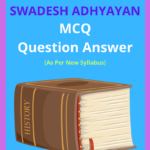Class 11 Swadesh Adhyayan MCQ Chapter 3 Resources Solutions, HS 1st Year Swadesh Adhyayan MCQ Notes, Class 11 Swadesh Adhyayan MCQ Chapter 3 Resources Question Answer to each chapter is provided in the list so that you can easily browse throughout different chapter Assam Board Class 11 Swadesh Adhyayan MCQ Chapter 3 Resources Notes and select needs one.
Class 11 Swadesh Adhyayan MCQ Chapter 3 Resources
Also, you can read the AHSEC book online in these sections Solutions by Expert Teachers as per AHSEC (CBSE) Book guidelines. AHSEC Class 11 Swadesh Adhyayan Multiple Choice Question Answer English Medium. These solutions are part of AHSEC All Subject Solutions. Here we have given AHSEC Class 11 Swadesh Adhyayan MCQ Notes for All Subject, You can practice these here.
Resources
Chapter – 3
SWADSH ADHYAYAN
MULTIPLE CHOICE QUESTION ANSWER
1. According to whom, “Resource does not mean any commodity or matter, but if that has utility and functionability can be regarded as resource”?
(i) Professor Zimmerman.
(ii) UNESCO.
(iii) Eratosthenes.
(iv) James Rennell.
Ans: (i) Professor Zimmerman.
2. Which of the following is known as Biotic resources?
(i) Living things.
(ii) Non living things.
(iii) Man-made resources.
(iv) Human resources.
Ans: (i) Living things.
3. Resources which are non-living or without having life or death do not consume any type of food or do not grow naturally are categorised under _________________.
(i) Biotic resources.
(ii) Abiotic resources.
(iii) Man-made resources.
(iv) Human resources.
Ans: (ii) Abiotic resources.
4. An example of abiotic resources are-
(i) Coal.
(ii) Sheep.
(iii) Deer.
(iv) Banyan tree.
Ans: (i) Coal.
5. Which of the following are dead animal consumers-
(i) Vulture.
(ii) Owl.
(iii) Sheep.
(iv) Zebra.
Ans: (i) Vulture.
6. Based on the structure resources are-
(i) Abiotic and biotic.
(ii) Renewable and non renewable.
(iii) Natural and man made.
(iv) None of the above.
Ans: (i) Abiotic and biotic.
7. Based on the process resources are-
(i) Abiotic and biotic.
(ii) Renewable and non renewable.
(iii) Natural and man made.
(iv) None of the above.
Ans: (iii) Natural and man made.
8. How many national parks in Assam?
(i) 7
(ii) 5
(iii) 8
(iv) 10
Ans: (i) 7
9. How many National Parks in India?
(i) 153
(ii) 156
(iii) 106
(iv) 10
Ans: (iii) 106
10. How many wildlife Sanctuaries in Assam?
(i) 7
(ii) 15
(iii) 17
(iv) 10
Ans: (iii) 17
11. How many wildlife Sanctuaries in India?
(i) 717
(ii) 155
(iii)1000
(iv) 565
Ans: (iv) 565
12. Which of the following is the largest National Park in Assam?
(i) Kaziranga national park.
(ii) Manah national park.
(iii) Orang national park.
(iv) Nambor national park.
Ans: (i) Kaziranga national park.
13. Which of the following is the smallest National Park in Assam?
(i) Kaziranga national park.
(ii) Manah national park.
(iii) Orang national park.
(iv) Nambor national park.
Ans: (iii) Orang national park.
14. Which of the following are the largest wildlife Sanctuaries in Assam?
(i) Marat Longri Wildlife sanctuary.
(ii) Nambor Wildlife Sanctuary.
(iii) Amchang Wildlife Sanctuary.
(iv) Garampani Wildlife sanctuary.
Ans: (i) Marat Longri Wildlife sanctuary.
15. Which of the following are the smallest wildlife Sanctuaries in Assam?
(i) Deepor Beel.
(ii) Nambor Wildlife Sanctuary.
(iii) Amchang Wildlife Sanctuary.
(iv) Garampani Wildlife sanctuary.
Ans: (i) Deepor Beel.
16. Garampani wildlife sanctuary is located in which district?
(i) Golaghat.
(ii) Karbi anglong.
(iii) Nagaon.
(iv) Jorhat.
Ans: (ii) Karbi anglong.

Hi! my Name is Parimal Roy. I have completed my Bachelor’s degree in Philosophy (B.A.) from Silapathar General College. Currently, I am working as an HR Manager at Dev Library. It is a website that provides study materials for students from Class 3 to 12, including SCERT and NCERT notes. It also offers resources for BA, B.Com, B.Sc, and Computer Science, along with postgraduate notes. Besides study materials, the website has novels, eBooks, health and finance articles, biographies, quotes, and more.




